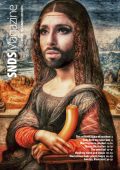I like living, breathing better than working … my art is that of living. Each second, each breath is a work which is inscribed nowhere, which is neither visual nor cerebral, it’s a sort of constant euphoria.
– Marcel Duchamp (1887–1968)
When the French artist Marcel Duchamp exhibited a mass-produced urinal in 1917, he shocked the art world and changed the way we look at art forever. “Readymades” – ordinary manufactured objects selected and modified by the artist – were here to stay: Simply by selecting, repositioning or joining, titling and signing it, the object became art.
Sometimes it seems like news media are following the same procedure:
The morning radio news stations read aloud from the front pages of the newspapers of the day, making the stories their own. Printed media copy-and-paste from websites and social media, reusing content made by others, with minimal changes, if any at all.
Repositioning, titling and (perhaps) signing it – a “readymade” news story is created. Fortunately, there’s a lot of original, self-produced material in most media as well, but when you hear the exact words on the radio that you have just read in the morning paper, it can be considered a waste of time.
But, of course – one always has the choice of turning off the news channels or putting the newspaper aside and succomb to the state of silence – or, as Duchamp put it – the art of living. This may even include periods of doing absolutely nothing, but this is not necessarily a bad thing – if you are able to appreciate the “aesthetic value of boredom”, which Duchamp also recognized, it may give you new inspiration and strength to get back to work.
This issue’s theme: Illustration
Modifying prefabricated material or readymade imagery is a technique used to great effect by both artists and illustrators, as this issue’s main theme shows. We have gathered a selection of works by illustrators from the Nordic countries and asked them a few questions about their work and the importance of illustration today.
It’s really encouraging to see how collage, drawing, and the carefully created visual storytelling is alive and kicking – in spite of cuts in budgets and in staff within probably all news organisations. The illustrators also have firm opinions about the role visuals can play in the broader picture – as Thomas Thorhauge says on page 23: “We need tools to express content fast and precise, transcending barriers of language, level of education and culture”.
 And visuals – or illustration – is the answer to that challenge. We gave a little extra space to Javier Muñoz, a freelance illustrator based in Bilbao, Spain, to show some of his great work for clients like The Guardian, Le Monde, and CNN. Though not afraid to use known imagery – such as the seminal Mona Lisa painting on which our wonderful cover illustration is based – he is not seaking the easy solution for his stories. When asked which of his illustrations he considers to be the best, he is not sure any qualifies – “the best one is yet to come”, as he says.
And visuals – or illustration – is the answer to that challenge. We gave a little extra space to Javier Muñoz, a freelance illustrator based in Bilbao, Spain, to show some of his great work for clients like The Guardian, Le Monde, and CNN. Though not afraid to use known imagery – such as the seminal Mona Lisa painting on which our wonderful cover illustration is based – he is not seaking the easy solution for his stories. When asked which of his illustrations he considers to be the best, he is not sure any qualifies – “the best one is yet to come”, as he says.
The third part of the illustration theme is an article by Ole Munk, who takes us behind the scenes of two different, yet similar situations in the process of creating the perfect combination of text and illustration.
Finally, we look at a new book about Swedish illustration – a heavy (literally and figuratively) publication which is a joy to read and experience if you want to know more about Sweden’s visual history in the 20th century.
The Fusion is near
The first part of this magazine, however, is filled with updates to the speaker list for the upcoming Fu2i0n14 conference, which will rock the city of Copenhagen on October 9th and 10th. Great speakers are coming, masterclasses will be held, and the winners of Gold and Silver Awards will be announced at the big Gala Dinner & Award Show. There’s even a big surprise for the winners of the Best Designed Awards this year – but you’ll have to show up in Copenhagen to see it yourself when it is shown to the world for the first time.
So see you in Copenhagen! You are guaranteed not to experience the aeshetic of boredom there, but your state of mind may rise to a sort of euphoria – if not a constant one as in Duchamp’s breathing, then at least a momentary one to bring home as inspiration.
Lisbeth Tolstrup & Lars Pryds
Editors, SNDS Magazine
.